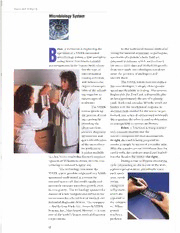
NASA Technical Reports Server (NTRS) 20020083274: Microbiology System PDF
Preview NASA Technical Reports Server (NTRS) 20020083274: Microbiology System
Health and Medic~n, Microbiology System B elow, a technician is explaining the In the traditional manual method of operation of a VITEK automated testing for harmful organisms, or pathogens, microbiology system, a time-and-labor- specimens of a patient's body fluid are saving device that detects harmful prepared in cultures, which are incubated microorganisms in the human body, identi- for two to three days and studied for growth; fies the type of from such study, microbiologists can deter- microorganism mine the presence of pathogens and causing infection, identify them. and indicates the The VITEK system does not replace degree of suscepti- the microbiologist, it simply allows greater bility of the offend- speed and flexibility in testing. The process ing organism to begins with the Test Card, a disposable plas- various types of tic kit approximately the size of a playing antibiotics. card. Each card contains 30 wells, which are The VITEK loaded with the biochemical reagents or system speeds up antimicrobials needed for the test to be per- the process of treat- formed; one series of cards is used to identify ing a patient by the organism, the other is used to determine providing the its susceptibility to various antibiotics. physician clear, Below, a Test Card is being marked accurate diagnostic with a sample number that the information and system's computer will read automatically. quick identification At right, the card is being prepared to of the most effect- receive a sample by means of a transfer tube. ive medication. After the samples are vacuum-drawn into the It makes available card's wells, the cards are sealed and loaded in a few hours results that formerly required into the Reader/Incubator (far right). upwards of 24 hours to obtain, thereby con- During a four to 24hour incubating tributing to reduced hospital stay. cycle (depending on the nature of the test), The technology that made the a photo-optical scanner periodically scans VITEK system possible originated in a NASA- each speci- sponsored study aimed at a system for men, moni- manned spacecraft that could rapidly and toring 1 accurately measure microbial growth, even changes in in zero gravity. The technology spawned for- cell growth, mation of a new company and served as the which are cornerstone for a broad line of medical and reported to industrial diagnostic devices. The company the comput- - bioMerieux Vitek, Inc., formerly VITEK er. When Systems, Inc., Hazelwood, Missouri - is now growth one of the world's largest medical diagnostic reaches a corporations. predeter- tractor for the initial NASA project begun in 1966. Aware of the com- mercial potential, McDonnell Douglas invest- ed several years of comp any development effort in what became known as the AutoMicrobic System, the ancestor of VITEK SR. and VITEK JR., then created VITEK Systems as a sub- sidiary to produce and market the system. When VITEK was divested by McDonnell Douglas in 1989, the company became part of the well- known globally-operating French pharmaceutical diagnostics company mined level, it indicates the presence of bioMerieux. With that merger, the com- pathogens. A preliminary report may be bined firm became the eighth largest med- requested at any time; the final report is ical diagnostic corporation in the world. printed automatically as soon as the results are available. This basic technology is employed in two configurations: the VITEK, with a test card capacity from 60 to 240, and the VITEK JR:, a scaled down version (30 cards) I designed to maximize laboratory efficiencies at both large and small hospitals. A companion system called VIDAS (VITEK Immune Diagnostic Assay System) is a totally automated system that detects bacteria, viruses, toxins and antibodies directly from patient specimens and pro- m vides immunochemistry results. VIDAS can operate as a stand-alone system or team with VITEK or VITEK JR.
